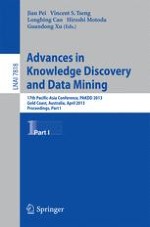The two-volume set LNAI 7818 + LNAI 7819 constitutes the refereed proceedings of the 17th Pacific-Asia Conference on Knowledge Discovery and Data Mining, PAKDD 2013, held in Gold Coast, Australia, in April 2013. The total of 98 papers presented in these proceedings was carefully reviewed and selected from 363 submissions. They cover the general fields of data mining and KDD extensively, including pattern mining, classification, graph mining, applications, machine learning, feature selection and dimensionality reduction, multiple information sources mining, social networks, clustering, text mining, text classification, imbalanced data, privacy-preserving data mining, recommendation, multimedia data mining, stream data mining, data preprocessing and representation.
